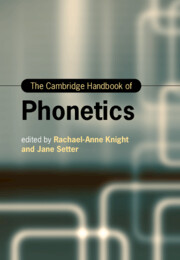Book contents
- The Cambridge Handbook of Phonetics
- Cambridge Handbooks in Language and Linguistics
- The Cambridge Handbook of Phonetics
- Copyright page
- Contents
- Figures
- Tables
- Contributors
- Introduction
- Section I Segmental Production
- Section II Prosodic Production
- 6 Stress and Rhythm
- 7 Lexical Tone
- 8 Intonation
- 9 Voice Quality
- Section III Measuring Speech
- Section IV Audition and Perception
- Section V Applications of Phonetics
- Index
- References
6 - Stress and Rhythm
from Section II - Prosodic Production
Published online by Cambridge University Press: 11 November 2021
- The Cambridge Handbook of Phonetics
- Cambridge Handbooks in Language and Linguistics
- The Cambridge Handbook of Phonetics
- Copyright page
- Contents
- Figures
- Tables
- Contributors
- Introduction
- Section I Segmental Production
- Section II Prosodic Production
- 6 Stress and Rhythm
- 7 Lexical Tone
- 8 Intonation
- 9 Voice Quality
- Section III Measuring Speech
- Section IV Audition and Perception
- Section V Applications of Phonetics
- Index
- References
Summary
This chapter covers two related prosodic phenomena: stress, i.e. the relative perceived prominence of individual syllables, and speech rhythm, the distributed prominence of syllables across stretches of speech and their perceived regularity in time. Both stress and rhythm can be viewed from the angles of perception and production, and speakers of different languages differ in how stress and rhythm are produced, perceived and interpreted for linguistic meaning. The chapter explains which articulatory and phonatory factors have been found to play a role in the production of stressed syllables, and distinguishes between stress and accent. The historically important concepts of rhythm classes and isochrony are presented in the context of current developments and debates. Three recent issues for research are presented in some detail: the analysis of stress in different languages, rhythm metrics, and rhythm and perception. The chapter further explores the role of rhythm for turn-taking in everyday talk, showing that conversationalists aim to rhythmically integrate their turns at talk with those of other speakers.
Keywords
- Type
- Chapter
- Information
- The Cambridge Handbook of Phonetics , pp. 159 - 184Publisher: Cambridge University PressPrint publication year: 2021
References
6.6 References
- 2
- Cited by



